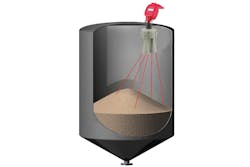For any means to the monitoring of bin, tank or silo inventories, a first question invariably asked is, "How accurate is it?"
Unfortunately, it’s a loaded question. It can’t be answered easily. But here’s a discussion about why it’s a tough question, and what can be expected from a level-monitoring system.
First to consider is the type of device used. Bobs, guided-wave radar, open-air radar and ultrasonic level sensors are the common currency. What they have in common is a strategy based on a measurement taken from a single point in the vessel. While each device has its pros and cons, installed properly any can be expected to perform to stated measurement accuracy.
But, what does the stated accuracy of measurement mean? For a single-point device, accuracy is often expressed based on the distance measured from the tank top’s sensor to the material surface. This distance is often referred to as "headroom," because it delineates how much space is left in the bin. This can usually be accurately expressed within ± 0.25 percent of the total distance measured.
However, that’s not a direct indicator of the accuracy of the bin material’s calculated volume or mass; it’s simply the accuracy of that single measurement.
What’s really wanted is the volume, the amount of three-dimensional space the material takes up. If what’s known is the distance from the sensor to the material surface, the estimated volume is derived based on that fact and the internal vessel dimensions. Known, accurate vessel dimensions preclude the mistakes that can lead to calculation error. Material flow, buildup or bridging can affect volume calculations. Sensor placement and filling and discharge point locations also impact overall accuracy of volume calculation.
Mass calculations
Accuracy can be further impacted when using a single-point measurement device to estimate mass or weight. When converting volume to mass, the bulk density of the material — stated in pounds per cubic foot or lb./ft.3 — can significantly impact accuracy. Although readily available resources reference a particular material’s bulk density, that of the material actually in the bin can be quite different than what’s posted on the Internet.
Particle shape, size and moisture content all impact bulk density. Material compaction also can cause very different bulk densities at bin top and bottom, for the same material. A cubic foot of material at the top of the bin could weigh less than that same material at the bottom, where the bulk density is greater due to compaction by material weight.
When using bulk density to calculate bin mass for a particular material, it’s important to establish an average bulk density based upon the actual material, not an amount stated in a reference table. One way to do this is taking measurements before and after a "known-weight" load is put in the bin, and then adjust the bulk density in lb./ft.3 to reflect this weight.
For single-point level measuring, further error is expected from the conversion of distance to volume and then mass.
As stated, measured-distance accuracy is around ± 0.25 percent. However, when level is used to estimate volume, accuracy depends upon correct, complete vessel dimensions, as well as information about sensor placement and location, and number of filling and discharge points. A vessel that is center-fill, center-discharge, with material flow free and symmetric, gives the best results with single-point measuring.
Inherent inaccuracies when converting a volume calculation to a mass calculation are due to bulk- density variations, regardless of whether single-point or multi-point measuring is used. Volume calculation accuracy impacts mass calculation accuracy.
With so many variables, single-point level-measurement device makers struggle to pinpoint how accurate the calculated mass value will be. However, with accurate vessel geometry, strategic sensor placement of the sensor, and a good average bulk density, mass accuracy of around 8 percent to 15 percent can be expected.
Multi-point accuracy
Unlike traditional devices that measure distance from a single point, a "3DLevelscanner" from BinMaster measures from multiple points within the silo to determine bin material volume. Measurement points are not averaged to calculate bin volume. Instead, each point is weighted for relevancy. A complex algorithm calculates the bin’s true material volume. By this means variations across the topography of the material surface are taken into account through measuring and mapping of high and low points.
The scanner configures an accurate three-dimensional profile of the storage material’s top surface. This is a benefit when there are material-surface variations due to multiple fill and discharge points, or with materials such as powders that do not fill or discharge symmetrically.
Volume accuracy remains dependent upon vessel dimension accuracy and sensor placement. When converting volume to mass, inherent inaccuracies persist due to bulk density variables. But, the improved accuracy of the volume calculation will improve mass calculation accuracy.
In this case, "more is better," with multiple measurement points contributing to a higher degree of accuracy. Given correct vessel geometry and proper sensor placement, you can expect volume accuracy of 3 percent to 5 percent. When combined with a good average bulk density, the accuracy of the mass may be around 5 percent to 10 percent.
Jenny Nielson Christensen, MBA, is vice president of marketing with BinMaster.
Established in 1953, BinMaster makes reliable, solid-state point and continuous bin level indicator and control systems and sensor devices used while storing or processing powder & bulk solids such as cement & aggregates, chemicals, feed & grain, food, plastics, biofuels, pharmaceuticals, pulp & paper and wood products.
